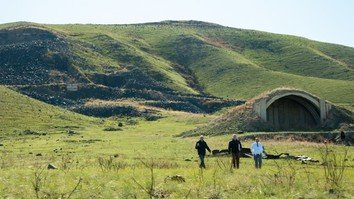NUR-SULTAN -- The construction of a storage facility in Almaty for spent radioactive materials is expected to be completed in October, according to Kazakhstan's Ministry of Energy.
The construction is a co-operative undertaking of the Ministry of Energy, the US Department of Energy and Global Affairs Canada.
The ministry's Institute of Nuclear Physics has a storage facility for spent sources of ionising radiation (SIRs), but this repository is 80% full.
The new facility will allow for the secure and ecologically safe storage of the radioactive materials once they are disused in medical and industrial applications, the Institute of Nuclear Physics said in a statement on its website.
![Representatives from Kazakhstan, the United States and Canada pose for a picture at the construction site of a storage facility for radioactive materials in Almaty on May 27. [Institute of Nuclear Physics]](/cnmi_ca/images/2020/08/18/25503-2-585_329.jpg)
Representatives from Kazakhstan, the United States and Canada pose for a picture at the construction site of a storage facility for radioactive materials in Almaty on May 27. [Institute of Nuclear Physics]
"The Institute of Nuclear Physics produces, for example, diagnostic radiopharmaceuticals for national health care. Building the facility, which will help safely store spent SIRs, is an important task right now," said Abubakir Sadykulov, a nuclear physicist from Akmola Province.
Using modern technologies in this area is "vital and goes hand in hand with safety", he said.
"The region doesn’t have a modern storage facility that enables long-term, safe storage of such radioactive materials up until the moment of their reprocessing or burial," said Ruslan Seksenbayev of Taraz, chairman of the non-governmental organisation (NGO) Beibit Aspan (Peaceful Sky).
"The assistance of foreign partners in building a facility like this, which is fitted out with all the essential up-to-date equipment, is very important and timely," he said.
In the hands of malign actors, these materials could be used in a "dirty bomb", which scatters dangerous radioactive material across a widespread area.
History of co-operation
Kazakhstan has a long history of co-operating with the United States on nuclear security. A joint nuclear non-proliferation programme has been in effect since 1993.
An important stage of this co-operation was the sealing of 181 nuclear-test tunnels at the Semipalatinsk (Semey) test site. Their users abandoned them after the collapse of the Soviet Union.
In late 2019 and early this year, two training courses on nuclear security took place in Kazakhstan for Kazakh specialists with the participation of trainers from the US Department of Defence and the US Department of Energy.
In January, the US Defence Threat Reduction Agency and Kazakhstan's National Nuclear Centre completed the construction of a training centre in eastern Kazakhstan to physically protect post-Soviet nuclear facilities.
Kazakhstan is also co-operating with the European Union on nuclear security and the nonproliferation of weapons of mass destruction.

![A site of the Kazakh Energy Ministry Institute of Nuclear Physics can be seen in this undated photo. [Institute of Nuclear Physics]](/cnmi_ca/images/2020/08/18/25502-1-585_329.jpg)






